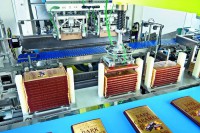Gerhard Schubert GmbH
TLM packaging line for cartoning
The SNC-F2 was the world's first packaging robot. When the Whittakers came across this innovation at interpack 1990, they decided to implement this flexibility as the new standard for packaging their fine chocolate at J. H Whittaker & Sons in Wellington, New Zealand. Since then, they have reordered from Gerhard Schubert GmbH in Crailsheim, Germany several times.
The SNC-F2 was the world's first packaging robot. When the Whittakers came across this innovation at interpack 1990, they decided to implement this flexibility as the new standard for packaging their fine chocolate at J. H Whittaker & Sons in Wellington, New Zealand. Since then, they have reordered from Gerhard Schubert GmbH in Crailsheim, Germany several times.
In June 2013, a TLM picker line for the cartoning of chocolate bars was put into operation. The TLM-F44 robots eliminate the need for a grouping chain, which ensures particular protection of the product. The chocolate manufacturer acts in accordance with comprehensive quality management "from bean to bar". It encompasses all of the links along the value-added chain in the service of Whittaker's premium brand. Consequently, strict standards also apply to the packaging. The paper wrappers and their imprints must remain pristine when the chocolate bars are cartoned to be sent to dealers all over the world. This is nearly impossible to fulfil using a conventional grouping chain. At the required rate of 240 bars / minute, the products would be cycled in a way that damage is inevitable.
TLM technology discovers another solution for this. Whittaker's chocolate bars are packaged in a gentle and extremely flexible way on a small footprint. The very compact packaging line consists of five sub-machines and integrates two transmodule sections. In addition, a Schubert palletizer is located in an adjacent room.
The system currently processes various types of 200g and 250g chocolate and packages them in wrap-around cartons (five formats) or cartons with a tray and lid (four formats). Depending on the packaging option the bars may be positioned horizontally or vertically in the carton.
A TLM-F3 robot removes two carton blanks from the magazine and transfers them to a TLM-F2 which runs them past the gluing nozzle and erects them in the folding unit. The robot places the cartons on a waiting transmodule.
TLM transmodules are single-axis, rail-based robots. Energy and data transfer is wireless. Once they are placed on the transmodule, the cartons on this conveyor unit are carried through all of the additional processes securely fixed by suction cups before they are transferred to the palletizer. There is a turning unit at each end of the rail section. Unloaded modules return to the other end on a lower track.
The second transmodule section is used to transport the products. Size plates on the transmodule provide compartments for stacking the chocolate bars, which is performed in the picker station. The TLM-F44 robots pick the bars up from the product belt and place them in the compartments of the size plate. When both stacks are complete, the transmodule proceeds to the filling station.
With this, the grouping process is completed. An intelligent VMS controller from Schubert is used to govern this process, rather than relying on a mechanism. The scanner detects the position and rotary orientation of the products in the picking station and immediately supplies the data for the quality control of each individual bar in the vision system. For many size changes, selecting the corresponding program on the control panel is sufficient. The tools of the pickers and transmodules can be exchanged quickly.
In the filling station, a TLM-F2 robot removes the two stacks of chocolate and places them in cartons. Depending on the size, the tool swivels the bars by 90 degrees before inserting them. For the wrap-around blank, the positioning accuracy of the transmodules has proven effective because the carton fits very closely. As a result, there is no room to move around.
In the next sub-machine, a TLM-F2 closes the cartons or puts on lids which were previously erected from flat blanks. The robot transfers the completely packaged chocolate bars to the discharge belt where they are marked or labelled using a laser printer. A conveyor device transports the cartons to the palletizer.

